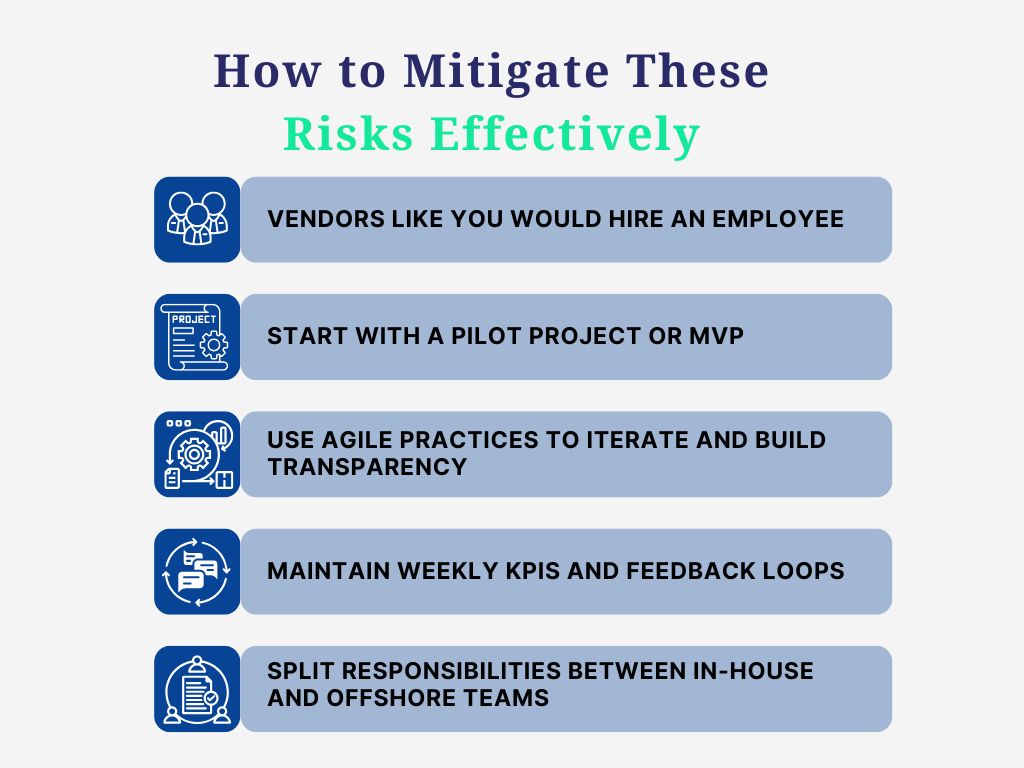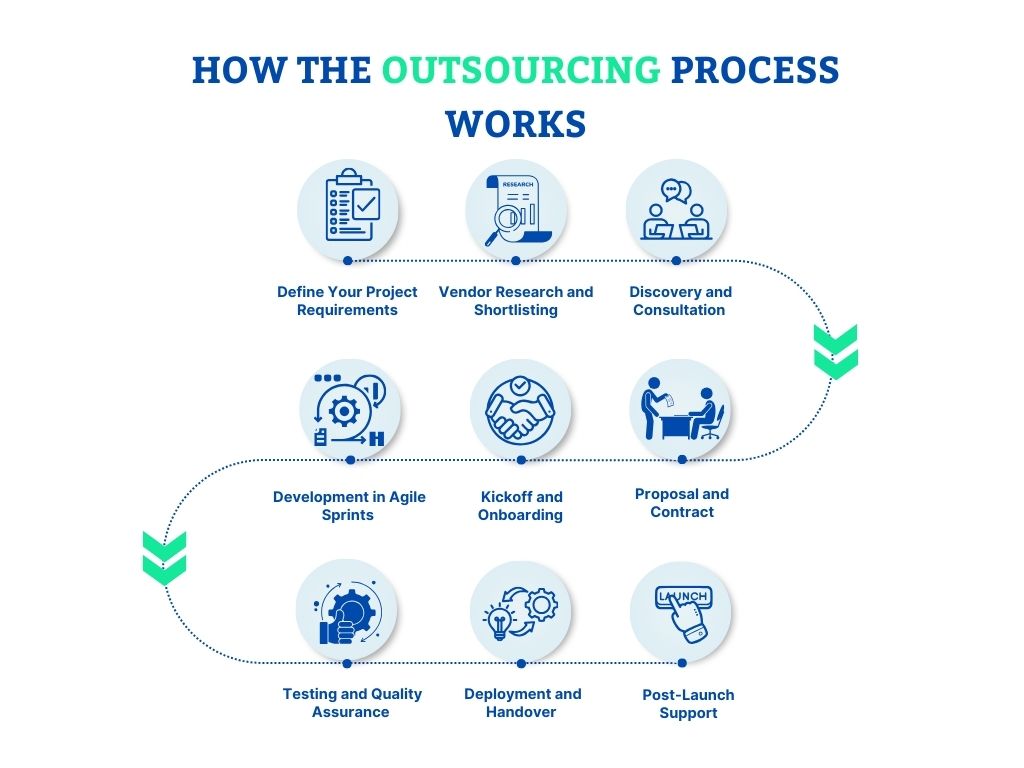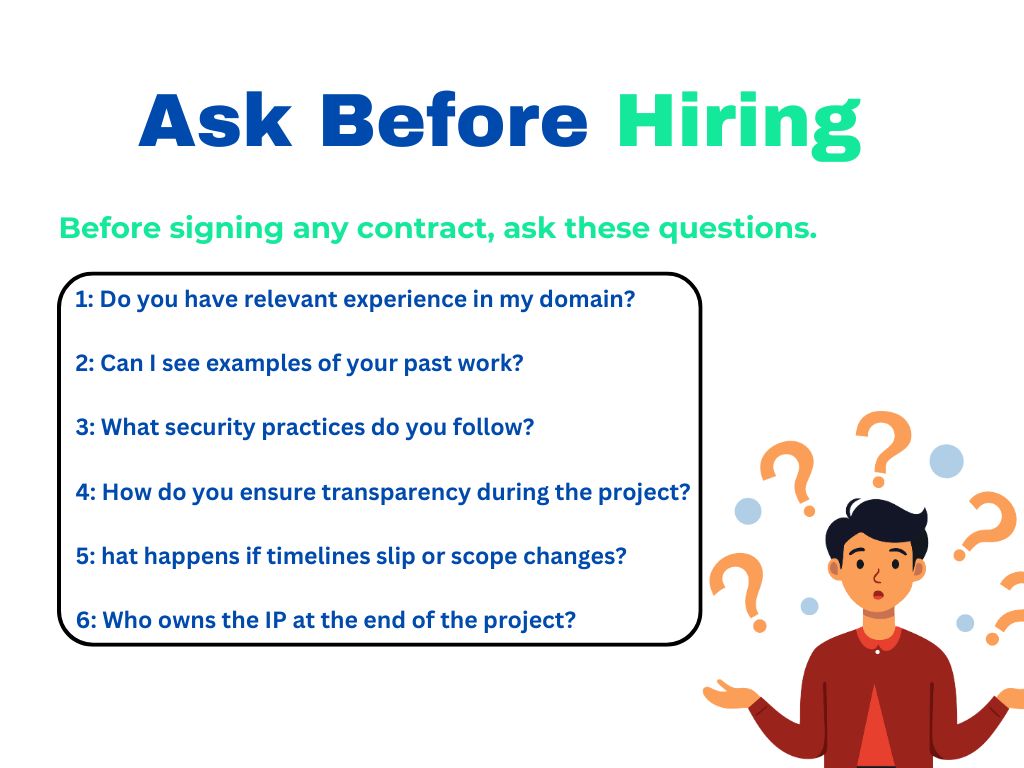Outsourcing software development can feel like the ultimate win—cutting costs, accessing global talent, and speeding up time to market. But what happens when things go wrong?
In 2025, as more companies lean into remote and offshore development models, the risks have become more complex-and more costly. A missed deadline. A security breach. A miscommunication that leads to building the wrong product.
This isn’t meant to scare you off. Instead, it’s a wake-up call to help you outsource smarter, not harder. In this blog, we’re unpacking the top risks of outsourcing software development, why they happen, and how to avoid them with confidence.
Whether you’re a startup founder testing an MVP or a CTO scaling a SaaS platform—this guide will help you avoid the pitfalls and build stronger, safer partnerships.
1. Compromised Software Quality
Not all development teams are created equal. Without proper vetting, you risk receiving buggy, unstable code that doesn’t meet your expectations. This can lead to rework, missed deadlines, and damage to your brand reputation.
Why it happens: Some offshore teams may lack the experience, skillset, or project management structure to deliver high-quality code consistently. Inadequate testing and unclear requirements can further degrade quality.
Fix it: Always check portfolios, conduct live technical interviews, and request a test project. Use clear documentation, design mockups, and regular QA checkpoints to maintain standards. Incorporate code reviews and automated testing tools like Selenium or SonarQube.
2. Data Security and Privacy Breaches
Sharing sensitive data with external teams can be risky if they lack secure systems. Data leaks, compliance issues, and misuse of intellectual property are real concerns, especially in industries like healthcare, finance, and e-commerce.
Why it happens: Insecure storage, lax access controls, or poor network protocols make systems vulnerable. Lack of understanding of international data regulations adds to the risk.
Fix it: Choose partners with ISO 27001, GDPR, or HIPAA compliance. Use NDAs, encrypted communication tools, secure file sharing platforms, and role-based access to sensitive areas. Ask vendors how they train their team on data privacy.
3. Communication Gaps and Misunderstandings
Time zones, language barriers, and lack of updates can lead to misaligned expectations and project delays. Miscommunication often results in feature mismatches, rework, and stakeholder frustration.
Why it happens: Differences in working hours and unclear communication processes often lead to delays in decisions and updates.
Fix it: Schedule overlapping work hours, use tools like Slack, Zoom, and Loom, and hold weekly sprint reviews. Create shared documents for tasks, requirements, and feedback. Encourage your team to over-communicate rather than under-communicate.
4. Limited Project Control
When development happens thousands of miles away, it’s easy to feel disconnected or out of the loop. Lack of visibility into daily progress can result in missed expectations and wasted resources.
Why it happens: You may not have direct access to the developers or visibility into their task board, timelines, or blockers.
Fix it: Assign an internal product owner to stay in sync. Use project management tools like Jira, Trello, or ClickUp to track every task and milestone. Ask for weekly reports, sprint retrospectives, and live demos.
5. Hidden and Unexpected Costs
Outsourcing may seem cheap—until hidden charges, extended timelines, or revision cycles kick in. These include change requests, extra QA cycles, deployment issues, or timezone-based communication inefficiencies.
Why it happens: Misaligned expectations, vague contracts, or under-scoping can lead to additional work billed later.
Fix it: Get everything in writing. Insist on detailed contracts with scope, deliverables, timelines, and a change management process. Use time-tracking tools to monitor productivity and forecast budget overruns early.
6. Overdependence on External Teams
If your entire tech stack is managed offshore, a breakup with your vendor can leave you stranded with no internal knowledge or backup.
Why it happens: Companies often try to cut costs by keeping all tech operations with the vendor, creating single-point dependency.
Fix it: Retain key technical roles in-house, like a product manager, tech lead, or architect. Regularly request documentation, source code backups, and system diagrams. Have a backup vendor on file for critical systems.
7. Legal and Compliance Challenges
Different countries have different rules. Ignoring regulations can lead to fines, lawsuits, or shutdowns. Data sovereignty, IP rights, and employment laws differ worldwide.
Why it happens: Many businesses assume that general NDA contracts are enough, without checking local data laws or export restrictions.
Fix it: Choose vendors who understand your country’s legal environment. Work with legal experts to draft contracts that include IP protection, confidentiality, dispute resolution, and data jurisdiction clauses.
8. Intellectual Property Risks
Your code, designs, and algorithms are valuable. Without proper protection, they can be reused or stolen. This risk increases with vendors who serve multiple clients in the same industry.
Why it happens: Lack of clear IP ownership in contracts or poor monitoring of code repositories can lead to unauthorized reuse.
Fix it: Sign NDAs and IP transfer agreements upfront. Define ownership rights in the Master Service Agreement. Use version control systems like GitHub with admin access and monitor contribution logs.
9. Cultural and Time Zone Differences
A simple misunderstanding can spiral into project delays. Cultural norms, holidays, and work ethics can affect timelines and collaboration.
Why it happens: Cultural assumptions, informal communication, and unspoken rules can disrupt workflows.
Fix it: Foster cultural awareness with short onboarding workshops. Learn about key holidays and schedule accordingly. Use tools like Google Calendar to sync time zones. Encourage regular check-ins for realignment.
10. Misalignment in Vision and Expectations
Even if communication is constant, your offshore team might not fully understand your long-term goals or user needs.
Why it happens: Developers focus on tasks instead of product goals, resulting in disconnected features and inconsistent UX.
Fix it: Share product vision documents, user personas, and business goals. Include the offshore team in early brainstorming sessions and retrospectives. Use product roadmaps and UX walkthroughs to align vision
11. Vendor Lock-In and Exit Barriers
Some vendors create systems that only they can manage or use proprietary frameworks that make switching costly and time-consuming.
Why it happens: You don’t receive full access to code, credentials, or documentation during development.
Fix it: Ensure contracts require the vendor to provide full documentation, source code, credentials, and IP transfer. Avoid black-box platforms and request regular data exports and admin training.
12. How to Mitigate These Risks Effectively
Risk mitigation doesn’t mean avoiding outsourcing—it means doing it smarter:
- Vet vendors like you would hire an employee
- Start with a pilot project or MVP
- Use agile practices to iterate and build transparency
- Maintain weekly KPIs and feedback loops
- Split responsibilities between in-house and offshore teams
Bonus tip: Conduct quarterly reviews to evaluate performance, risks, and improvements.
How the Outsourcing Process Works
Understanding how the outsourcing process works helps you stay in control, plan better, and choose the right partner. Here’s a detailed look at how most outsourcing software development engagements unfold:
Step 1: Define Your Project Requirements
Before reaching out to vendors, identify what you need:
- Project scope (what you’re building)
- Core features and technical specs
- Budget and timeline expectations
- Preferred tech stack or platform
Creating a project brief or product requirement document will make it easier for vendors to give you accurate proposals.
Step 2: Vendor Research and Shortlisting
Search for companies with relevant experience, strong reviews, and a professional online presence. Platforms like Clutch, Upwork, or LinkedIn are good places to start.
Look for:
- Case studies or portfolios
- Testimonials or client references
- Industry or technical expertise
Step 3: Discovery and Consultation
Once shortlisted, reach out for a consultation. Share your brief, discuss your goals, and ask key questions (refer to our checklist section). A strong partner will listen carefully, ask the right questions, and offer early suggestions.
Step 4: Proposal and Contract
Vendors will respond with a proposal that outlines:
- Project scope
- Team structure and roles
- Timeline and phases
- Pricing and payment milestones
- Tools and communication plans
If the proposal fits, move to the contract stage. Ensure legal clauses protect your IP, data, and budget.
Step 5: Kickoff and Onboarding
The project begins with a kickoff meeting. You’ll meet the team, finalize communication channels (Slack, Zoom, Jira), and align on delivery expectations.
Onboarding includes:
- Sharing technical documentation or designs
- Setting up shared repositories and tools
- Defining sprint goals and review schedules
Step 6: Development in Agile Sprints
Most vendors use Agile methodology:
- Work is divided into sprints (1–2 weeks)
- Each sprint delivers a working version of the software
- Regular sprint reviews allow you to give feedback and adjust
Daily standups and weekly demos keep everyone aligned.
Step 7: Testing and Quality Assurance
QA engineers test the product at each stage:
- Functional testing
- Performance testing
- Security testing
Bugs are reported, tracked, and resolved before moving forward.
Step 8: Deployment and Handover
Once the product is tested and approved:
- It’s deployed to your production environment
- You receive final documentation, credentials, and IP
- Admin access is transferred to your team
Step 9: Post-Launch Support
A good outsourcing partner provides:
- Bug fixes and patches
- System monitoring
- Feature enhancements based on feedback
You can continue working with the same team under a support or retainer agreement.
Final Tip: Stay involved at every step. Successful outsourcing depends on collaboration, not just delegation.
13. Checklist: What to Ask Before Hiring an Outsourcing Partner
Before signing any contract, ask these questions:
- Do you have relevant experience in my domain?
- Can I see examples of your past work?
- What security practices do you follow?
- How do you ensure transparency during the project?
- What happens if timelines slip or scope changes?
- Who owns the IP at the end of the project?
A strong vendor will answer confidently and offer real examples, not just promises.
FAQs
1. What is the biggest risk of outsourcing software development?
The biggest risk is often poor communication, which can lead to misunderstood requirements, delays, and unsatisfactory results. Clear communication protocols and regular check-ins help avoid this.
2. How can I ensure my outsourced team follows data security best practices?
Ask for security certifications like ISO 27001, ensure NDAs are signed, use encrypted tools, and confirm they follow GDPR, HIPAA, or other compliance standards relevant to your industry.
3. What should be in an outsourcing contract to reduce risk?
Key items include clear deliverables, timelines, revision processes, IP ownership clauses, NDA, dispute resolution terms, and a detailed payment schedule.
4. How do I maintain control over an outsourced software project?
Use tools like Jira or Trello for transparency, assign a dedicated in-house project lead, and establish sprint planning, demos, and retrospective reviews.
5. What red flags should I watch for in an outsourcing partner?
Lack of transparency, vague proposals, no references, poor communication, and no clear process are all signs of a potentially unreliable partner.
6. Can outsourcing affect my company’s long-term flexibility?
Yes, especially if the vendor uses proprietary systems or fails to transfer knowledge. Always request documentation, open access, and training throughout the project









